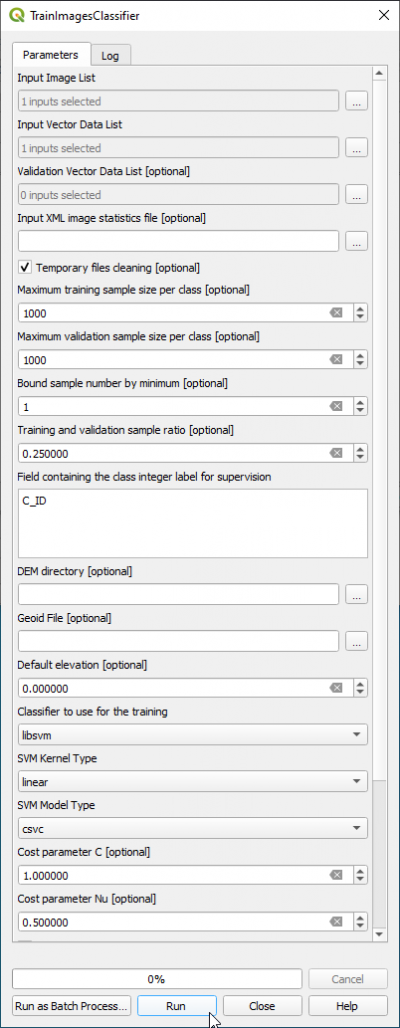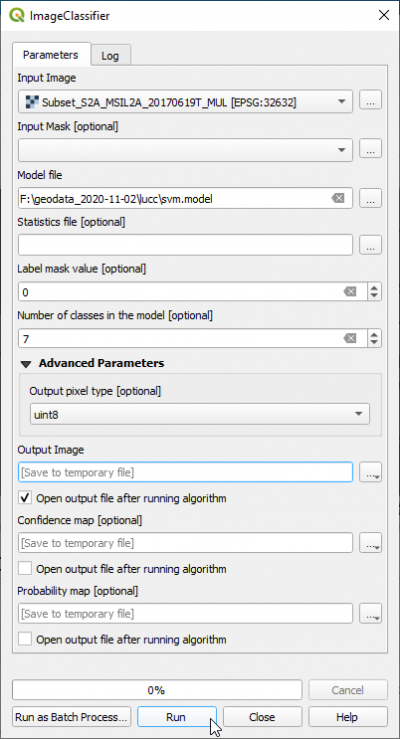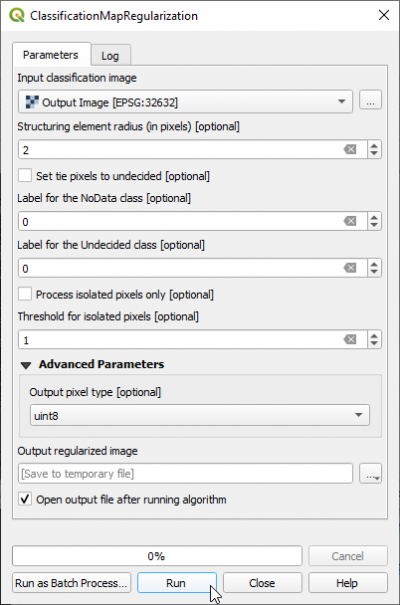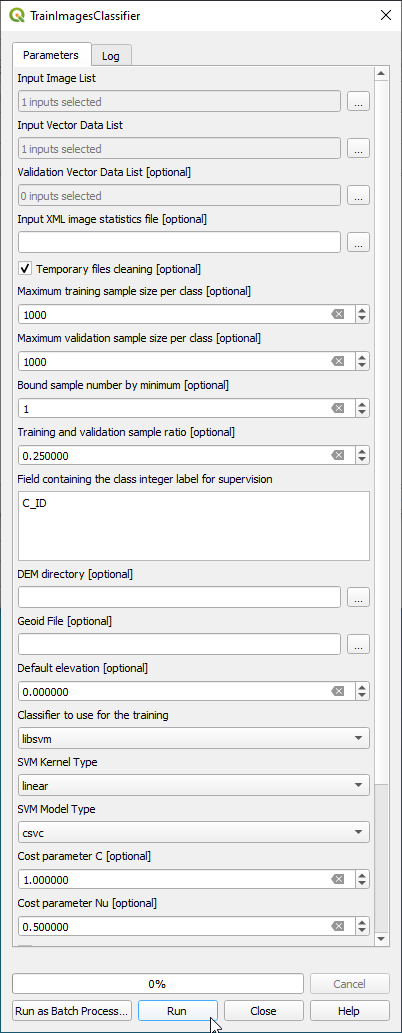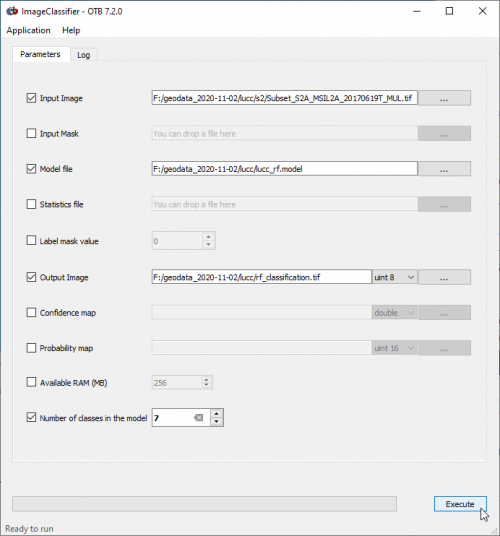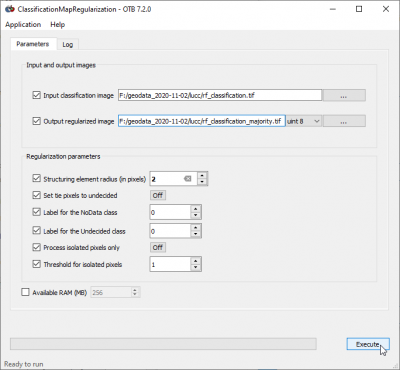Supervised classification (Tutorial)
From AWF-Wiki
Contents |
Per pixel classification with QGIS and OTB processing plugin
In OTB Version 7.0.0 the requirements for the input vector data are very restrictive becuase of some bug.
- File format needs to be Shapefile (GPKG does not work).
- The column containing the class label needs to integer (whole number). (integer 64bit does not work!)
- Any other columns with other date types (real or text (string) with umlauts or blank are not correctly imported which leads to failure.
All these issues have been fixed in OTB Version 7.1.0!
- file format needs to be shapefile.
Training phase
- In the search engine of Processing Toolbox, type TrainImages and open TrainImagesClassifer.
- In the Input Image List select a (or optional: several) multispectral images: mosaic_S2A_MSIL2A_20200521T102031_N0214_R065_T32UNC_UNB_UPC.tif.
- In the Input Vector Data List choose a vector polygon file with training areas: training_2020-05-21.shp.
- In the Validation Vector Data List and choose a vector polygon file with an independent sample of validation areas: leave empty.
- Training and validation sample ratio: Template:Text. This is a 4-fold cross-validation with split 0.75 per cent for training and 0.25 per cent for testing.
- Type Code in the {button|text=Field Name}} text field.
- Choose Support Vector Machine Classifer libsvm from the drop down list.
- SVM Model Type is csvc
- User defined input centroids: Type any character, no need for a filename. This field is required and but ignored (a bug in the OTB plugin!)
- The SVM Kernel Type is Linear.
- Switch checkbox Parameters optimization on.
- In the Output model specify an model file: e.g. svm.model
- Define an output file for Output confusion matrix or contingency table (e.g.svm_matrix.csv).
- Click Run.
- Click on the Log tab and inspect the model quality measures: Precision, Recall, F-score and Kappa index.
Classification phase
- In the search engine of Processing Toolbox, type ImageClassifier and double click ImageClassifier.
- Set mosaic_S2A_MSIL2A_20200521T102031_N0214_R065_T32UNC_UNB_UPC.tif as Input image.
- Set Input _mask to blank (top of drop-down list).
- Set lucc_svm.model as Model file.
- Set Output pixel type to uint16
- Save the Output image as svm_classification.tif.
- Uncheck Confidence map: Open output file after running algorithm.
- Add svm_classification.tif to QGIS canvas.
- Find the prepared style file rast_classifcation.qml in the Tutorial data of Workshop 05.
- Right click svm_classification.tif in the TOC and select Properties --> Style --> Style --> Load Style.
- Select the style file svm_classification.tif. OK.
- Open the text file svm_matrix.csv with LibrOffice Calc or MS Excel and calculate overall, user, producer accuracy.
Postprocessing
This application uses a majority filter with a circular structure element.
- In the search engine of Processing Toolbox, type classification and double click ImageClassifier.
- Define Input classification image as an classification output raster.
- Set Structuring element radius to 2 pixels.
- Set Output pixel type to uint16.
- Save the Output regularizd image as svm_classification_majority.tif.
- Click Run.
Per pixel classification with OTB standalone
Training phase
- Type into the search box of the Windows taskbar: mapla.bat. Click on mapla.bat to open Monteverdi Application Launcher.
- In the search engine of mapla, type TrainImages and double click TrainImagesClassifer.
- In the Input Image List click on + and select a (or optional: several) multispectral images: Subset_S2A_MSIL2A_20170619T_MUL.tif .
- In the Input Vector Data List choose a vector polygon file with training areas: lucc_training_input.shp.
- Activate the checkbox Validation Vector Data List and choose a vector polygon file with an independent sample of validation areas: lucc_validation.shp
- In the Output model specify an output model file: e.g. lucc_svm.model
- Activate the checkbox and save the Output confusion matrix or contingency table as lucc_svm_confusion.csv.
- In the Bound sample number by minimum field type 1.
- Set the training and validation sample ratio to 0. (0 = all training data).
- Mark C_ID in the Field containing the class integer label (C_ID refers to the column that contains the LUC code in the training and validation vector file).
- Choose LibSVM classifier from the drop down list as Classifier to use for the training.
- The SVM Kernel Type is Linear.
- The SVM Model Type is C support vector classification.
- Switch the Parameters optimization to on.
- Check user defined seed and enter an integer value.
- Click on Execute.
- Click on the Log tab and inspect the quality measures: Precision, Recall, F-score and Kappa index.
Classification phase
- In the search engine of mapla, type ImageClassifier and double click ClassifcationMapRegularization
- Set Subset_S2A_MSIL2A_20170619T_MUL.tif as Input image.
- Set SVM.model as Model file.
- Save the Output image as svm_classification.tif.
- Evaluate classification results:
- Add svm_classification.tif to QGIS canvas.
- Download the style file classifcation.qml from Stud.IP.
- Right click svm_classification.tif in the TOC and select Properties --> Style --> Style --> Load Style.
- Select the style file \lucc\classification.qml. OK.
- Open the text file lucc_svm_confusion.csv with LibreOffice Calc or MS Excel and calculate overall, user, producer accuracy and kappa index.
Postprocessing
This application uses a majority with a circular structure element.
- In the search engine of mapla, type, regular and double click ClassifcationMapRegularization.
- Define Input classification image as ans classification output raster.
- Save the Output regularizd image as svm_classification_majority.tif.
- Set Structuring element radius to 3 pixels.
- Set Output pixel type to uint8.
- Click Execute.
